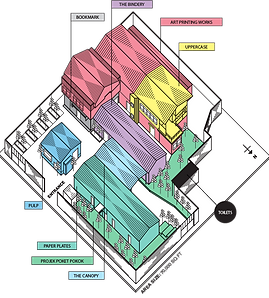
FORM & FUNCTON
What is the RELATIONSHIP?
Last week, we talked about form follows function or function follows form.
The doctrine “Form Follow Function” by Louis Sullivan makes an important mark to the architecture line.
Generations argue the title with different perspective of view. Whether which follow which, this week we are going to talk about the relationship among them.
Form and Function, what is the meaning and what make a relationship among these two words?
Different people from different decade have their own perspective view to interpret the relationship between form and function. Throughout the lifespan of architecture, the relationship develops from unequal to equal. At previous time, people focusing too much on ArtDeco, the exterior outlook, the form of a building. They build a structure without much consideration on the function of the building as at that time, they think of the much art, ornament, fancy form they did have could represent the wealth of the people.
The trend started to change when the generation find out that function is much more important than the form as the example of French Hotel displays rooms of an elaborate sequence and a spatial variety born of internal necessity, masked by a rigorous, well-proportioned external facade. However, from PETER EISENMAN‘s point of view, he stated that form and functions should come together equally and post-functionalism s concerned with both humanism and modernism in terms of form and function. This is how the relationship between Form and Function changing throughout the years of architecture, the thinking of human had changed.


BEFORE
AFTER
One example that could describe the relationship between form and function throughout lifespan of an architecture work is The Factory, by Ricardo Bofill located at Sant Just Desvern, Espanya.
The cement factory was previously a WW1-era pollution machine. The “function” and program has changed from the adaptive reuse. From cement factory with simple form has repurposed into a resident with some changes on the outlook. Meaning, from “function more than form” to the equal.
Bofill covered the exterior with luscious, green vegetation and the roof also been transform into green roof. The transformation process began with the demolition of part of the old structure to leave hitherto concealed forms visible, as if the concrete had been sculpted. Once the spaces had been defined, cleaned of cement and encompassed by new greenery, the process began of adaptation to the new program.
Now, the status of form and function start changing to equal.
The 8 silos remained and became office, models laboratory,archives,library,projection room and “The Cathedral” which used for exhibitions (function adaptive reused from the space created).
Thus, I agreed with Eisenman’s view which form and function should be equal when we come to design and Bofill did a good example in which the relationship between form and function through adaptive reuse.












Talk about “function”, there is deeper meaning inside . The purpose, function, use of the building is related.(From Richard Hill- “PURPOSE, FUNCTION, USE.”)
Let us have a quick review on Hill’s text. Hill argued on importance to define and differentiate purpose and function with his saying“ Purpose denotes a human intention in relation to an object, and function denotes the object’s execution of that purpose.”
For an example, a knife is with its function to cut, with our purpose to use it to cut an apple, the whole action became a use. To get “use” the humanity/program behind is very important. If we did not take a purpose or program to cut an apple the knife is functionless and it is useless.Hence,from my personal view, function,purpose,use are related to humanity in which having some related to Eisenman’s view which stated that humanism is a concern in terms of form and function.

“Purpose and Function are related, but only in such successful cases.”
Robert Hill.
Yes, i agree with it ,did with having “pedagogic system”.
From the case studies, I think that APW,Bangsar had did a good example of adaptive reuse in term of its function and pedagogic system.Previously,APW was a art printing company and now it had been transformed into a multi-purpose functional places which including Food Beverage, Office and Exhibition Center.
From the original purpose as a printing company ,the owner had adapted and reuses the whole site into a commercial zone. The program behind had changed, function and purpose changed but also in a relation. The building is to function as a commercial area but it is more complete with the purpose of human such as having breakfast in APW, rent a space as office in APW, which humanism and pedagogic system joined into. There is a purpose, namely that people will have breakfast in APW, and the function of the APW is to fill that purpose.

BEFORE ADAPTIVE REUSE

AFTER ADAPTIVE REUSE
With other case studies, The House of Vans London is also an example of adaptive reuse in term of program and function. The house of Vans sits within the 150 year old brick arches of the railway lines had been repurposed into a cultural hub for skateboarding,art,film and music. Utilising the layout of tunnel, the program of the tunnel has change, function and purpose has change from a tunnel into a happening cultural hub.
 |  |
|---|---|
 |  |
 |
From my point of view, form and function are related with purpose,program,humanism and the usage. I agreed on the both view from Eisenman and Hill. As an architect, we should able to differentiate the meaning of words., and ability to transform a structure or space into a better version.
Remember:
Function is to fulfil purpose with a human’s use and pedagogic system behind.



